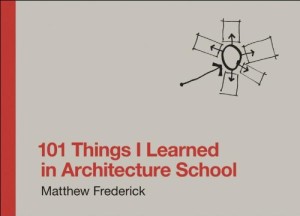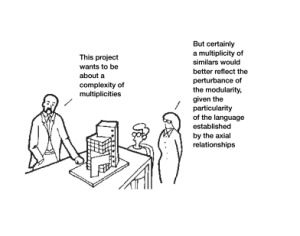 We’re continuing to read through Frederick’s handy reference guide for architects and designers in general.
We’re continuing to read through Frederick’s handy reference guide for architects and designers in general.
Perhaps the most salient point worth considering is that of language. I occasionally struggle with the question “what do you do for a living?”
The answer is either a short “I design websites,” or the more complicated, and oft followed with a look of bewilderment, “I’m a user experience designer.”
Despite communication being a primary part of my job, particularly with non-technical individuals, or communicating between various technical teams within their own jargon, I struggle with the very thing that makes me so successful at work, outside of work
If you can’t explain your ideas to your grandmother in terms that she understands, you don’t know your subject well enough. (page 106)
What exactly is experience? And what is it about something which is so universal, that seems so opaque most. Everyone has emotional reactions to things: whether television programs, electronic devices, meals ordered at restaurants. Somehow it seems kind of elusive for most to imagine that there is someone behind the scenes in all of these cases thinking about what they’re doing and how it may bring out a certain feeling in the person experiencing it.
Is it because we couch our language in that of psychology? At work many are comfortable with the notion that we’re using psychology to gain insight into what people do and how we can do it better; however, when that same thought is applied to the more quotidian interactions in one’s day, is there a resistance? Has the power of psychology become so mired by the valid critiques of Freud’s psychoanalysis and the subliminal advertising schemes of the unscrupulous (and very few!)? Or do we only see it as a modern-day practice which occurs behind closed doors replete with couches and notebooks?

Finding a Way Out
I tend to begin explaining what I do by referencing industrial design, and in particular mimic the strategy used in the first chapter of Donald Norman’s The Design of Everyday Things.
I often begin with the teapot metaphor. With so few affordances, it continues to this day to be a classic example, and easily grasped by anyone over the age of three. How many other objects have preschool sing-alongs that clearly enumerate the affordances, forcing mechanisms, constraints, error prevention, and user feedback systems endemic to good design?
How many other objects have preschool sing-alongs that clearly enumerate the affordances, forcing mechanisms, constraints, error prevention, and user feedback systems endemic to good design?
By relying on industrial design metaphor for user experience design, some of the complexity and accuracy in what I do is lost. Sure, some of my great aunts might think that I design teapots. But conceptually? I’d rather have them understand the concept than to know how to jump in on the next project and know where to help me out next.
I suppose something is lost by not providing context around the psychology of the teapots’ users. Maybe we should have done a study at Thanksgiving dinner where we all watched each other make a cup of tea, and then analyzed what we saw and how the teapot’s users felt. But something is gained by sharing a concept so deep that some of us can devote an entire career to mastering, in a way that’s so simple that we can all grasp it and get on to what’s important: what kind of tea are we having? (and after all, isn’t that the heart of what good user experience is?)
